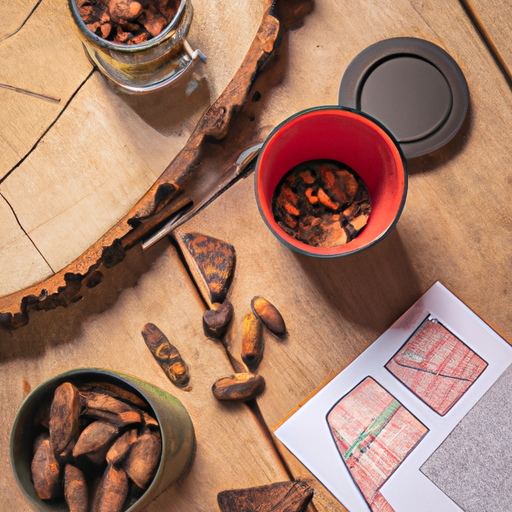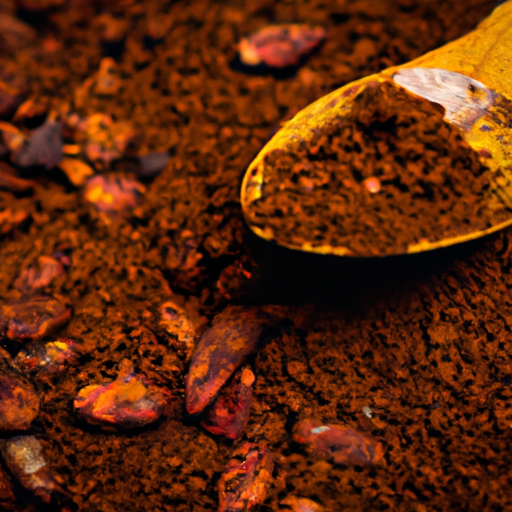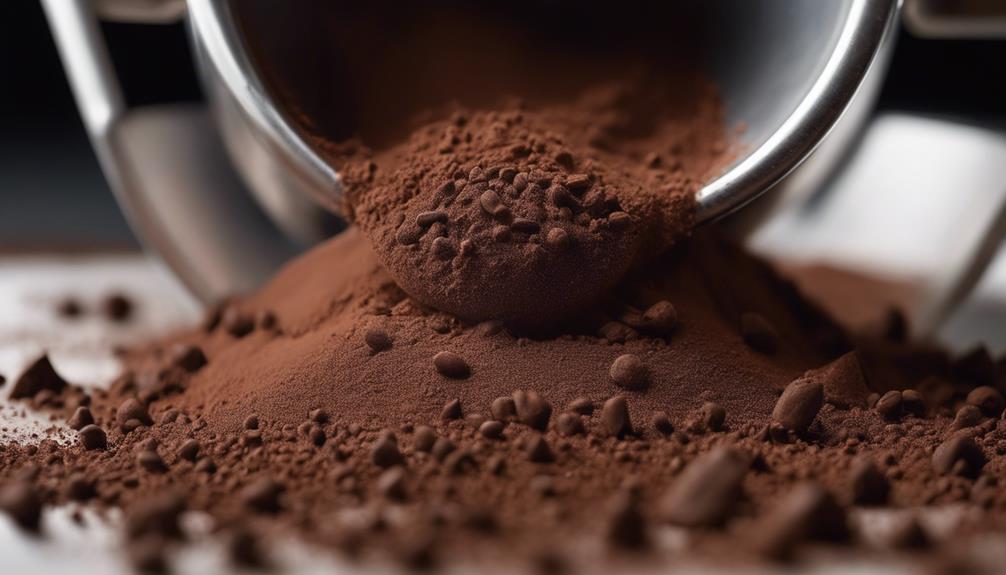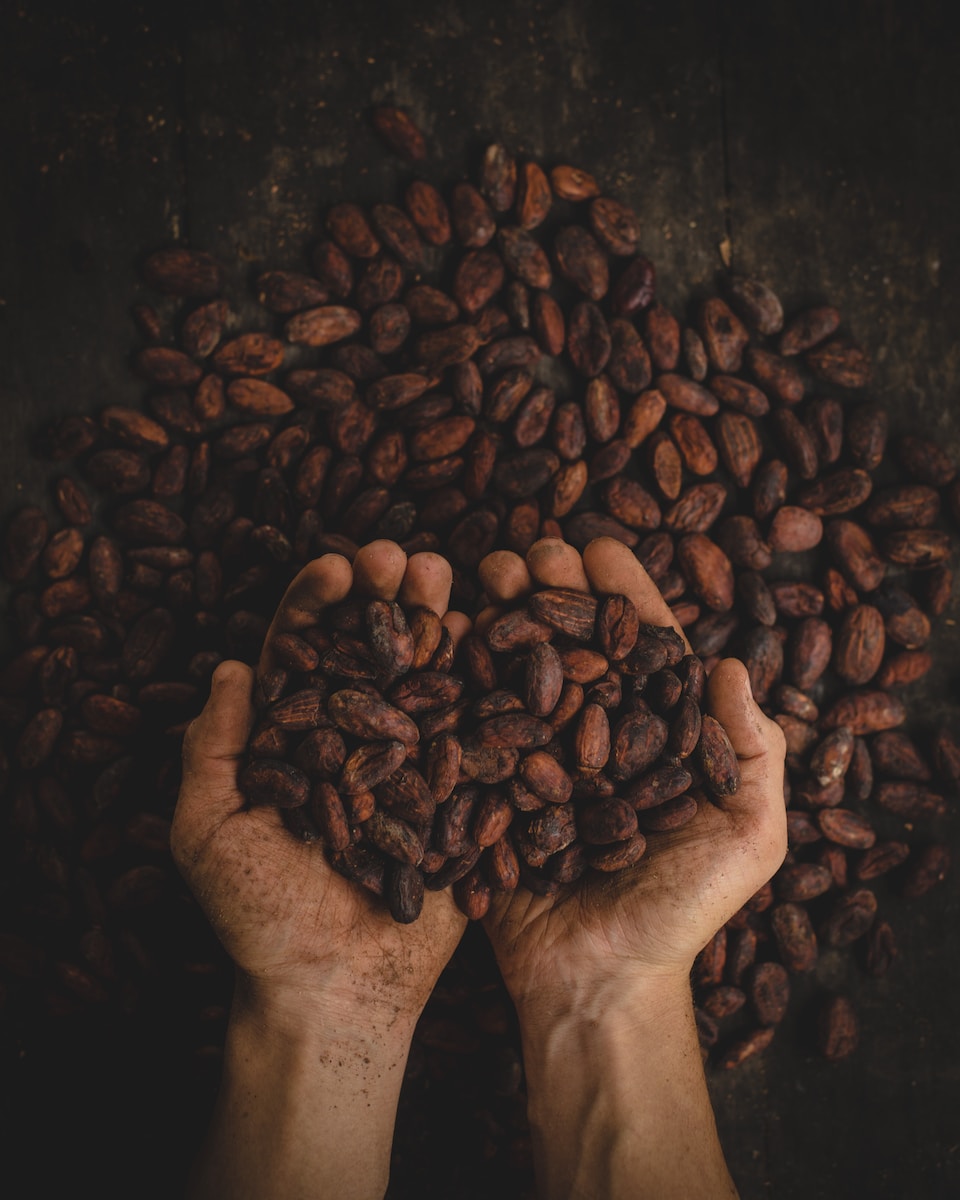In this article, we will discuss the numerous benefits of adding raw cacao to your diet, including its potential for weight management, its effects on skin health, and mental well-being.
We will also delve into the differences between raw cacao and processed chocolate, and the potential side effects of consuming too much.
So, grab a cup of your favorite hot beverage, sit back, and join me on this scrumptious journey as we unravel the mysteries of raw cacao and discover how much is just the right amount to savor each day.
The Health Benefits of Raw Cacao
You should definitely indulge in a few cups of raw cacao each day to reap its incredible health benefits!
Raw cacao is packed with antioxidants, which help protect your cells from damage caused by harmful free radicals.
It also contains flavanols, which have been shown to improve heart health by reducing inflammation and lowering blood pressure.
Additionally, raw cacao is a good source of magnesium, iron, and fiber, which are all important for maintaining a healthy body.
To incorporate raw cacao into your daily routine, try adding it to smoothies, oatmeal, or homemade energy bars. There are also plenty of delicious raw cacao recipes available online.
So go ahead and enjoy the recommended serving size of raw cacao each day to support your overall well-being.
Recommended Daily Intake of Raw Cacao
Indulging in a daily dose of raw cacao can provide you with a boost of antioxidants, which help improve heart health and reduce the risk of chronic diseases.
When it comes to the recommended serving size of raw cacao, it’s important to keep moderation in mind. Here are four key points to consider:
-
Balance is key: While raw cacao has numerous health benefits, consuming excessive amounts can lead to unwanted side effects such as digestive issues and increased heart rate.
-
Stick to the guidelines: It is generally recommended to consume no more than 1-2 tablespoons of raw cacao powder or nibs per day.
-
Listen to your body: Everyone’s tolerance to raw cacao may vary, so pay attention to how your body reacts and adjust your intake accordingly.
-
Consult a healthcare professional: If you have any specific health concerns or conditions, it’s always best to consult with a healthcare professional for personalized advice.
Incorporating raw cacao into your diet can be an enjoyable and nutritious addition.
Incorporating Raw Cacao into Your Diet
Adding a touch of raw cacao to your favorite smoothie or baked goods can bring a deliciously rich and velvety flavor to your diet. Not only does raw cacao taste amazing, but it also offers several health benefits.
When incorporating raw cacao into your recipes, you can start by adding a tablespoon or two to your smoothies. The earthy and slightly bitter taste of raw cacao pairs perfectly with fruits like bananas and berries. You can also experiment with adding raw cacao to your baked goods, such as cookies or brownies, for a decadent twist. Remember to use recipes that specifically call for raw cacao to ensure the best results.
By incorporating raw cacao into your diet, you can enjoy its unique flavor and reap the potential health benefits it offers.
Now let’s explore the difference between raw cacao and processed chocolate.
Raw Cacao vs. Processed Chocolate
When it comes to choosing between raw cacao and processed chocolate, there are several key points to consider.
Firstly, raw cacao is known to contain higher levels of antioxidants, minerals, and vitamins compared to processed chocolate.
Secondly, by opting for raw cacao, you can avoid added sugars and artificial ingredients that are often found in processed chocolate.
Lastly, it is important to make informed food choices by understanding the nutritional differences between the two options and considering the health benefits associated with consuming raw cacao.
Nutritional Differences
Consuming raw cacao offers a range of nutritional benefits that can enhance your overall well-being. Raw cacao has a rich nutritional profile, packed with essential minerals like magnesium, iron, and zinc. It is also a great source of fiber and healthy fats.
One of the key advantages of raw cacao is its high antioxidant content. Antioxidants help protect your cells from damage caused by free radicals, reducing the risk of chronic diseases. Additionally, raw cacao contains flavonoids, which have been linked to cardiovascular health and brain function.
By incorporating raw cacao into your diet, you can enjoy these nutritional benefits and support your body’s health. It’s important to note that when consuming raw cacao, it’s best to avoid added sugars and artificial ingredients, as they can negate the positive effects.
Transitioning into the subsequent section, it’s crucial to be mindful of what you add to your raw cacao to maximize its benefits.
Avoiding Added Sugars and Artificial Ingredients
Nutritional differences between raw cacao and processed chocolate are significant, as discussed in the previous subtopic. However, it is essential to be mindful of the additional ingredients often found in commercial chocolate products. By avoiding added sugars and artificial sweeteners, we can embrace a clean eating lifestyle and benefit from the natural alternatives provided by raw cacao. To paint a clearer picture, let’s compare the ingredients commonly found in raw cacao versus processed chocolate:
| Raw Cacao | Processed Chocolate |
|---|---|
| 100% cacao | Sugar, milk powder |
| No added sweeteners | Artificial flavorings |
| No artificial additives | Emulsifiers |
As we can see, raw cacao offers a pure and unadulterated source of nutrients, making it a healthier choice. By choosing natural alternatives and avoiding artificial ingredients, we can make informed food choices that promote our overall well-being. Now, let’s delve into the importance of understanding food labels to make even more knowledgeable decisions.
Making Informed Food Choices
Understanding food labels allows us to uncover hidden ingredients in our favorite treats and make more informed choices for our health. Making healthy snack choices is crucial for maintaining overall health. Our food choices have a significant impact on our energy levels, mood, and weight. When selecting snacks, it’s important to look for options that are low in added sugars and artificial ingredients. Whole foods like fruits, vegetables, and nuts are excellent choices as they provide essential nutrients without unnecessary additives. These nutrient-dense snacks can fuel our bodies and keep us feeling satisfied throughout the day. By making informed food choices, we can support our overall well-being and promote a healthier lifestyle.
Transitioning into the subsequent section about raw cacao and weight management, it’s important to consider the role it plays in our diet.
Raw Cacao and Weight Management
Raw cacao is a great addition to a weight management plan. It is high in fiber, which helps to keep you feeling full and satisfied.
Additionally, raw cacao supports metabolism, which can aid in weight loss.
It is also satiating and can help to reduce cravings for unhealthy snacks.
High in Fiber
Consuming a moderate amount of raw cacao daily can contribute to a well-balanced diet. This is because raw cacao is high in fiber, which plays a crucial role in maintaining a healthy digestive system and promoting regular bowel movements. In fact, raw cacao is a great source of dietary fiber, with approximately 4 grams per ounce.
Here are some high fiber benefits of incorporating raw cacao into your diet:
- Helps regulate blood sugar levels
- Supports healthy weight management
- Reduces the risk of heart disease
- Promotes satiety and helps control cravings
Including raw cacao in your daily routine can provide you with these fiber-rich benefits. Additionally, raw cacao supports metabolism, which will be discussed in the next section.
By including raw cacao in your diet, you can enjoy its high fiber content and support your overall well-being.
Supports Metabolism
Imagine if you could effortlessly boost your metabolism and burn those pesky calories simply by indulging in the deliciousness of raw cacao. Not only does raw cacao satisfy your sweet tooth, but it also supports digestion and boosts energy levels. The high fiber content in raw cacao aids in digestion by promoting regular bowel movements and preventing constipation. Additionally, raw cacao contains natural compounds that stimulate the release of endorphins, providing a natural energy boost.
To better understand the benefits of raw cacao for metabolism and digestion, take a look at the following table:
| Benefits of Raw Cacao | ||
|---|---|---|
| Boosts Metabolism | Supports Digestion | Increases Energy Levels |
Incorporating raw cacao into your daily routine can provide these advantages, helping you maintain a healthy metabolism and digestive system. Additionally, it can enhance your energy levels, allowing you to power through your day. With these benefits in mind, let’s explore how raw cacao is also satiating and reduces cravings.
Satiating and Reduces Cravings
When it comes to supporting metabolism, raw cacao has proven to be quite beneficial. But now let’s shift gears and talk about how it can also be satiating and reduce cravings.
Consuming raw cacao can help you feel fuller for longer periods of time, thanks to its high fiber content. This can be particularly helpful if you’re trying to manage your weight or control your appetite.
Additionally, raw cacao contains compounds that have been shown to reduce cravings, especially for sweet and unhealthy foods. By incorporating raw cacao into your diet, you may find it easier to resist those tempting treats and stick to a healthier eating plan.
And speaking of health benefits, let’s explore how raw cacao can positively impact your skin health.
Raw Cacao and Skin Health
Raw cacao has several benefits for skin health. Firstly, it contains antioxidants that protect the skin from damage caused by free radicals. These unstable molecules contribute to aging and skin diseases. Additionally, the antioxidants in cacao promote blood flow and hydration, resulting in a healthy and youthful appearance. Raw cacao is also rich in vitamins and minerals like magnesium, zinc, and sulfur, which are essential for maintaining healthy skin. There is no specific recommended daily amount for skin benefits, but incorporating a moderate amount of raw cacao into your diet, such as a couple of cups a day, can enhance your skin’s health and radiance.
Raw Cacao and Mental Well-being
Indulging in the velvety richness of raw cacao can be a soothing balm for the mind, like a warm embrace on a chilly winter’s day. Raw cacao has been found to have potential benefits for mental well-being. Here are five ways raw cacao can support your mental health:
-
Raw cacao and stress relief: Consuming raw cacao can help reduce stress levels by stimulating the production of endorphins, the ‘feel-good’ hormones in our brain.
-
Raw cacao and cognitive function: The flavonoids found in raw cacao have been linked to improved cognitive function, including enhanced memory and focus.
-
Antioxidant properties: Raw cacao is packed with antioxidants that protect the brain from oxidative stress, which can contribute to mental decline.
-
Mood enhancement: Raw cacao contains phenylethylamine (PEA), a compound that promotes the release of serotonin and dopamine, neurotransmitters associated with mood regulation.
-
Relaxation and calmness: The magnesium content in raw cacao can help relax muscles and promote a sense of calmness.
These benefits make raw cacao a delicious and beneficial addition to your diet. However, it is important to be aware of any potential side effects of raw cacao, which will be discussed in the next section.
Potential Side Effects of Raw Cacao
When it comes to consuming raw cacao, there are a few potential side effects to be aware of.
Firstly, caffeine sensitivity may be a concern for some individuals, as raw cacao contains a natural stimulant called theobromine.
Allergic reactions are another possibility, as some people may have an intolerance or allergy to cacao.
Lastly, digestive issues such as bloating or diarrhea can occur due to the high fiber content in raw cacao.
It’s important to be mindful of these potential side effects and listen to your body when incorporating raw cacao into your diet.
Caffeine Sensitivity
Given one’s sensitivity to caffeine, it’s advisable to moderate the amount of cups of raw cacao consumed daily. Caffeine can have various effects on individuals, including its impact on sleep and anxiety levels. Here are three important points to consider:
-
Caffeine and sleep: Consuming too much caffeine, such as that found in raw cacao, can interfere with your sleep patterns. It may cause difficulties falling asleep or lead to disrupted sleep throughout the night.
-
Caffeine and anxiety: For those prone to anxiety, excessive caffeine intake can potentially worsen symptoms. It may increase feelings of restlessness, irritability, and even trigger panic attacks in some individuals.
-
Individual tolerance: Sensitivity to caffeine varies from person to person. It’s crucial to listen to your body and adjust your intake accordingly. If you notice negative effects on your sleep or anxiety levels, it may be wise to reduce the amount of raw cacao consumed.
Considering these factors, it’s important to be mindful of your caffeine sensitivity when consuming raw cacao. It’s worth noting that allergic reactions can also occur, which will be discussed in the following section.
Allergic Reactions
I’ve already mentioned the potential issues that can arise from consuming too much caffeine when it comes to raw cacao. But another important aspect to consider is the possibility of allergic reactions.
Like any food, raw cacao can trigger allergic reactions in some individuals. While true cocoa allergies are rare, some people may experience cross reactivity with other foods, such as tree nuts or legumes.
It’s important to be aware of any food allergies you may have and to consult with a healthcare professional if necessary. They can help you determine if raw cacao is safe for you to consume and provide guidance on appropriate intake.
Now, let’s transition into the next section and discuss the potential digestive issues that may arise from consuming raw cacao.
Digestive Issues
Be cautious, as indulging in too much of this tempting treat might leave your stomach feeling like a tumultuous sea. While raw cacao offers numerous health benefits, it can also lead to digestive issues, especially for those with food intolerances.
Some individuals may experience bloating, gas, or even diarrhea after consuming raw cacao. If you have a known sensitivity to cacao or other foods, it is advisable to consume it in moderation or avoid it altogether.
However, if you still want to enjoy the benefits of raw cacao without the digestive discomfort, there are natural remedies that may help. Ginger, peppermint, and chamomile are known for their soothing effects on the digestive system and can be consumed alongside raw cacao to minimize any potential discomfort.
In conclusion, enjoying raw cacao in moderation is key to reaping its benefits without experiencing digestive issues.
Conclusion: Enjoying Raw Cacao in Moderation
To truly savor the benefits of raw cacao, why not indulge in a moderate daily dose of this delectable delight? Enjoying raw cacao in moderation allows you to reap its many health benefits while still maintaining a balanced diet. Here are four reasons why incorporating a moderate amount of raw cacao into your daily routine can be beneficial:
-
Boosts mood: Raw cacao contains compounds that stimulate the release of endorphins, promoting feelings of happiness and well-being.
-
Enhances cardiovascular health: Studies have shown that the flavonoids in raw cacao can improve blood flow, lower blood pressure, and reduce the risk of heart disease.
-
Provides antioxidants: Raw cacao is packed with antioxidants that help protect the body against damage from free radicals.
-
Supports brain function: The flavonols in raw cacao may improve cognitive function and protect against age-related mental decline.
By enjoying raw cacao in moderation, you can indulge in its delicious flavor while reaping its numerous health benefits.
Frequently Asked Questions
Can eating too much raw cacao be harmful to my health?
Yes, eating too much raw cacao can have potential side effects. It is important to stick to the recommended daily intake to avoid issues like digestive problems, caffeine sensitivity, and mineral imbalances.
Can raw cacao consumption cause allergies or sensitivities?
Raw cacao consumption can potentially cause allergies or sensitivities, leading to digestive issues or skin reactions in some individuals. It is important to be aware of any adverse reactions and consult a healthcare professional if necessary.
Is raw cacao safe to consume during pregnancy or while breastfeeding?
Raw cacao consumption during pregnancy or breastfeeding: Is it safe and beneficial? It is generally safe to consume raw cacao in moderation during pregnancy and breastfeeding, but it’s important to consult with a healthcare professional for personalized advice.
How does raw cacao affect blood sugar levels?
Raw cacao can have a positive effect on blood sugar levels by improving insulin resistance and glycemic control. Studies suggest that moderate consumption of raw cacao can be beneficial for maintaining healthy blood sugar levels.
Are there any interactions between raw cacao and certain medications or supplements?
Raw cacao can interact with certain medications and supplements. For example, it may increase the risk of bleeding when taken with blood thinners. It’s important to consult with a healthcare professional for potential side effects.
What Are the Health Benefits of Eating Raw Cacao in Moderate Amounts?
Eating raw cacao in moderate amounts can offer several health benefits. The antioxidants in raw chocolate recipe from cacao can help improve heart health, reduce inflammation, and lower blood pressure. Additionally, it may boost mood and cognitive function, and provide essential minerals like magnesium and iron.
Conclusion
In conclusion, incorporating raw cacao into your daily diet can offer numerous health benefits. However, it is important to consume it in moderation.
Just like adding a sprinkle of raw cacao to your morning smoothie can elevate its taste and nutritional value, savoring a small piece of dark chocolate can bring joy and pleasure to your day.
Remember, balance is key. So, go ahead and enjoy the goodness of raw cacao, but always listen to your body and ensure a well-rounded diet.










